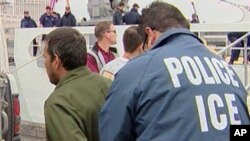Each year, the United Nations estimates that up to 900,000 men, women and children are trafficked across international borders. Many are lured from their homelands with promises of well-paying jobs. Instead, they often are coerced into prostitution and other types of forced labor. It's a modern form of slavery that top U.S. officials say threatens national security, and to raise awareness about it, President Barack Obama declared January, National Slavery and Human Trafficking Prevention Month.
The United States is a destination country for thousands of men, women and children trafficked from all corners of the world. But it does not get much attention, says John Morton, the director of U.S. Immigration and Customs Enforcement, or ICE, and it should because of the sheer inhumanity of the problem.
"Once they [people] understand what’s really going on, that children are being forced to work in horrible abusive conditions, or girls are being forced into prostitution or young boys are being forced into prostitution, people are fathers, people are brothers or sisters," Morton said. "They get that there is a basic wrong to this."
The U.S. State Department estimates that up to 17,000 people, primarily women and children, are trafficked to the United States annually. U.S. officials are trying to combat the problem by educating the public about the dangers and signs of human trafficking. Morton says prosecuting traffickers and dismantling their bases, is a challenge. "Even when you do find a victim, you’ve got to build a case and you have to have victims that are willing to testify," he stated.
That’s hard for a lot of victims. They are very, very afraid of their traffickers. Two: going after the sort of root causes in many of these countries; the conditions that fuel the level of trafficking that we see in some of these cases, attitudes toward women and girls."
Andrea Bertone is a specialist on human trafficking and directs a web site that focuses on the problem. She praises ICE's efforts, but she says more is needed to help victims. "That would be to improve our networks and communications with ethnic communities that tend sometimes to stay in closer knit. Authorities don’t feel comfortable accessing their communities, but, in fact, the better understanding we have of closer knit ethnic communities, the better we can find those labor and sex trafficking victims," Bertone explained.
Another Washington-based advocacy group, FAIR Fund, seeks to prevent human trafficking and sexual violence from destroying the lives of young people, especially girls . Andrea Powell is its executive director and says her organization sees about 1,000 cases a year.
"One of the biggest challenges we face is, with all our outreach and advocacy, we are identifying young people who are being victimized," Powell said. "And we have very few places we can take them that are adequately prepared for extremely, extremely traumatized child,” she said.
Andrea Bertone and John Morton say victims mainly come from Asia, Eastern Europe and Latin America, and ICE maintains contacts and offices in many countries in those regions in an effort to stem the flow.
"We train lots of foreign law enforcement on how to tackle this problem, how to investigate and how to work with us because all these cases end up involving transnational criminal networks that are moving people from one country to another," Morton said.
Morton says last year ICE opened more than 650 cases involving human trafficking and made 300 arrests, the agency's highest number ever.









